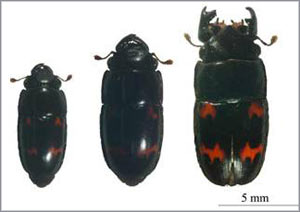Why do the little guys still have mates?
In the beetle world, the big guys often win the race to find a mate, by grabbing the enemy's love to chase it away. But the biggest is not always the best. All beetles - large, medium or small - can be lucky.
For different sizes, animals choose different stratagems to find their partners, evolutionary biologist Takahisa Miyatake from Okayama University in Japan and his colleagues, found.
The beetles in the study are distributed throughout Japan. They live on plastic seeping from oak trees. The largest males wait for the females on the foraging grounds - in the experiment are thin banana slices - and then beat

The biggest bugs are not necessarily the luckiest.For every different size, beetles have their own tips for finding a mate.(Photo: LiveScience)
each other to win the right to mate.
In such times, the male with the largest jaw will have the most chance of winning.
The beetles of medium size - too small to defeat the giants - grow in relatively larger wings than the wings of their large type. Thanks to the wings' ability to fly far away, the average guys who came to the cafeteria were not taken by the big males, and tried to enlist the feelings of the girls here.
The smallest males choose a completely different plan - they use their relatively large testicles. They stood in the cafeteria with the big guys and then sneaked on the females behind the other males. They can produce sperm that are more competitive than larger males.
The findings are published on the latest issue of Ecological Entomology magazine.
- Behind the
- Extinguish desire to keep your partner
- Bird's nest is smart
- Why do female mates eat mates before mating?
- Close up of the screen rushing into a glass plate under extremely slow rotation
- Bad habits of animals
- Birds use scents to seduce mates
- How do hummingbirds find mates?
- Video: The way to flirt with a strange capuchin monkey
- Dinosaurs also wagged their tails when flirting with their partners
- 'Urine love story' has 1-0-2 of tilapia
- Crows attract mates like people
 Why do potatoes have eyes?
Why do potatoes have eyes? 'Tragedy' the world's largest carnivorous life: Death becomes ... public toilet
'Tragedy' the world's largest carnivorous life: Death becomes ... public toilet Tomatoes were once considered 'poisonous' for 200 years
Tomatoes were once considered 'poisonous' for 200 years Detecting microscopic parasites on human face
Detecting microscopic parasites on human face